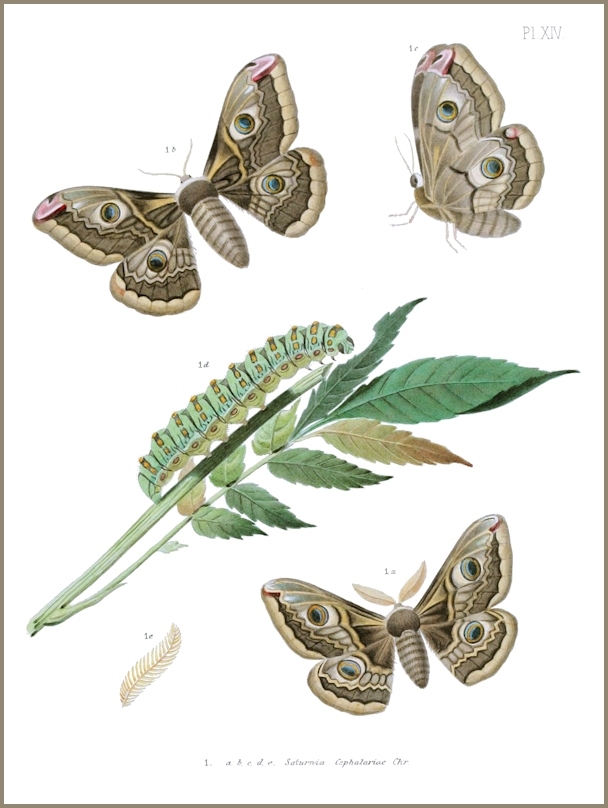UK: Armenian Emperor Moth, RUS: Saturniya zakavkazskaya.
Saturnia cephalariae Christoph, 1885, in Romanoff, Mém. Lépid. 2: 14.Type locality: Kasikoparan, Kars Province, Turkey.
(Taxonomic note. Up until recently this species was regarded as a subspecies of Saturnia spini; however, there are major differences in the ecology and early stages of the two species (de Freina, 1979; Nässig, 1981).)

Holarctic; western Palaearctic region. Pleistocene refuge: Monocentric -- Iranian refuge.
Wingspan 55--100mm, with females being the larger. Male antennae are large and more than one third the length of the forewing (de Freina, 1979). Both sexes are almost indistinguishable from those of Saturnia spini, i.e. the adults are not sexually dichromatic. A detailed comparison between the two species is given by De Freina (1979).

In behaviour, very similar to that of Saturnia spini; however, Saturnia cephalariae occurs at 2000-3000m altitude -- Saturnia spini has only been recorded below 1500m. A species of damp sub-alpine montane meadows and rocky slopes strewn with patches of woodland (de Freina, 1979).
Unlike Saturnia pavonia, both males and females of this species are nocturnal and pair during the hours of darkness.
May to June as a single generation, with some individuals in late April.
OVUM: Oval, 1.4 x 2.2mm, greyish-white with olive-brown gum. Laid in clusters around flowering stems of the host, and sometimes on the leaves.
LARVA: Full-fed 65--80mm. Monomorphic. In all its stages very like that of Saturnia pavonia. First instar larvae are black (Christoph, 1885), with some green coloration appearing in the second or third instar. Beyond this point they become solitary (de Freina, 1983). Full-grown larvae are not black like those of Saturnia spini, but mainly green or greenish-yellow with black markings or bands. Tubercles usually purple.
Larvae consume a great deal of hostplant and grow at an 'amazing' rate (Christoph, 1885; de Freina, 1979). Small larvae are to be found on the upper parts of the host, whereas larger larvae prefer resting under more mature leaves nearer the ground (de Freina, 1979).



Hostplants. Monophagous on Cephalaria procera (Christoph, 1885), but will accept other members of the scabious subfamily (Dipsacaceae [now part of the Caprifoliaceae]) in captivity, e.g. Knautia. They generally will not feed/survive on Prunus or Crataegus (de Freina, 1983), although this species has been reared on Sanguisorba officinalis (de Freina, 1994).
PUPA: 26mm. Dark brown to black, noticeably dorso-ventrally flattened, and 'comma'-shaped. Formed in a coarse, thin-walled, pear-shaped, double, unsealed brown cocoon at ground-level, which is noticeably larger and darker than that of Saturnia spini (de Freina, 1983). The overwintering stage, which may lie dormant for several years (de Freina, 1979). Very tolerant of cold, dry conditions.
Species not recorded, but the larvae were seen to be 'followed' by both a large ichneumonid wasp and tachinid fly (de Freina, 1979).
Confined to parts of the Anatolian Plateau above 2000m altitude, particularly eastern Turkey (Kars Province). It has also been found locally in the Turkish provinces of Bayburt, Erzurum, Van and Hakkari (Mehmet Çelik, iNaturalist 2013), at Manglisi (near Tbilisi) and Lake Kartsakhi in the Republic of Georgia, and in Armenia (Zolotuhin, Didmanidze & Petrov, 2011; Mathias Prat, iNaturalist 2007); however, any records from outside Kars Province need to be carefully checked. Reported but not confirmed from northwestern Iran.
Extra-limital range. None.

None.
 Return to species list
Return to species list